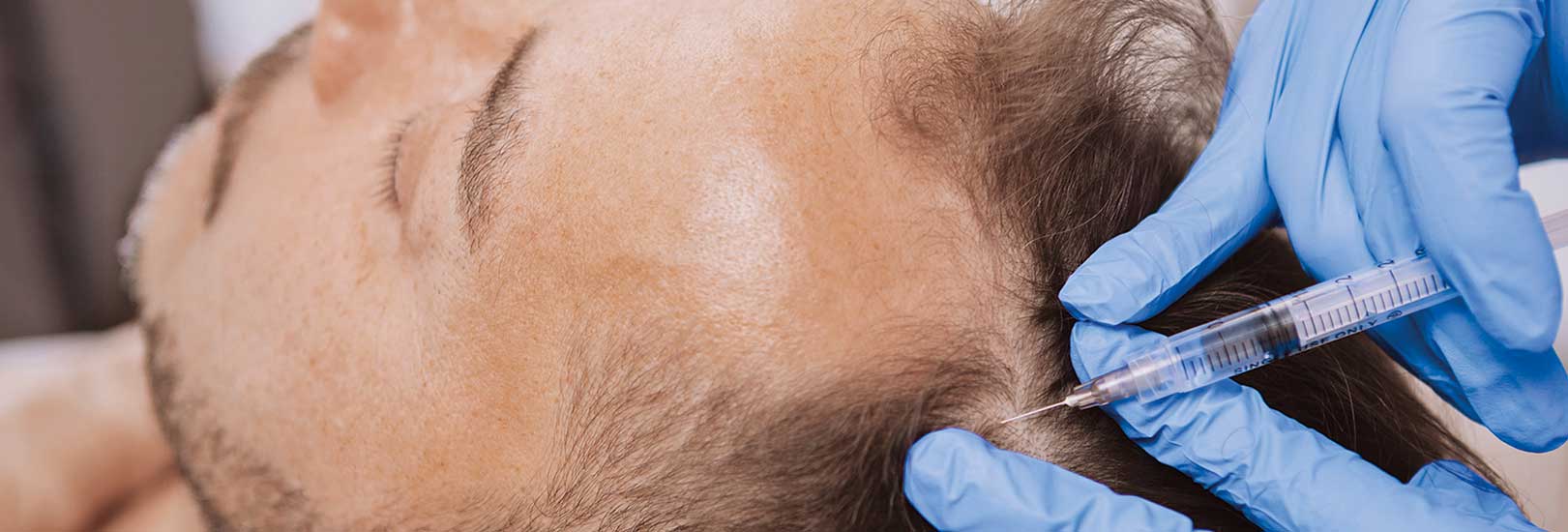Dr. Manuel Calzado
Internal Medicine
Hair Health and Surgery Consultation

New therapeutic options in Androgenic Alopecia
HPA Magazine 14
Androgenic Alopecia (AGA) is a hereditary loss of hair due to the effect of androgenic hormones on hair follicles in genetically susceptible men and women. This type of alopecia appears due to the enzyme 5-alpha-reductase (5R) in testosterone. This hormone is present in both sexes with a highest incidence in males.
The enzyme acts on testosterone and transforms it into dihydrotestosterone, which adheres to the receptor causing hair follicle atrophy, which will result in weakening and subsequent hair loss. As a consequence hair follicles become smaller, resulting in shorter, thinner hair. In addition to the hormonal mechanism, there are recent studies that show how there may be other factors that interfere in AGA etiopathogenesis in men, such as microinflammation, alteration of the prostaglandin pathway or changes in the Wnt-beta-catenin pathway.
There are currently no permanent treatment options available for AGA. This pathology affects approximately 70% of men and 40% of women at some stage in their lives. Men generally experience receding hairline of the temples and hair loss in the crown of the head, while women experience hair thinning all across the top of the scalp.

The treatment methods currently available include pharmacological and non-pharmacological options:
- · non-pharmacological - vitamin supplements, amino acids, platelet-rich plasma, low-power laser and even hair transplant;
- · pharmacological therapies include minoxidil, stromaprogestin therapy and antiandrogenic drugs (orally or mesotherapy).
Although there is a wide variety of therapeutic options, AGA remains an unresolved therapeutic problem, with topical Minoxidil and Finasteride, the only approved treatments in most countries and, therefore, considered first-line treatment.
MESOTHERAPY WITH ANTI-ANDROGENS
The dutasteride microinjection technique (also known as anti-androgenic infiltration or dutasteride mesotherapy) is a new treatment for male and female androgenic alopecia, involving the application of dutasteride microinjections directly to the scalp, so that a higher concentration reaches the root of the hair follicle, in this way, the medication will act directly on follicles thickening the hair and stopping hair loss. The procedure is carried out under local anesthesia of the scalp, making it a virtually painless technique. It takes about 30 minutes to take effect and does not require any prior or subsequent care from the patient. It leaves no visible marks and the patient can immediately return to his activities (driving, working, leisure).
SCIENTIFIC EVIDENCE OF THE PROCEDURE
There are more and more studies that support oral dutasteride as being more efficient when compared to oral finasteride. Dutchasteride inhibits 5R 1 and 2 isoenzymes with greater potency than finsteride (which only inhibits isoenzyme 2), in fact, 3 times more potent in inhibiting type 2 5R isoenzyme and 100 times more potent in inhibiting type 1. Decreases serum dihydrotestosterone levels by about 90% compared to pre-treatment values. Its average life span has a long duration, approximately 4-5 weeks, allowing treatment sessions to be evenly spaced. The dutasteride microinjections are a safe and potentially effective alternative in the treatment of AGA. In the future the use of this treatment is likely to increase, especially in patients where oral treatment is contraindicated or as a complementary treatment for AGA, due to the fact that the patient´s hormone levels do not show significant hormonal differences before and after this type of treatment.
CAN IT BE COMBINED WITH OTHER TREATMENT?
One of the advantages of the dutasteride microinjection procedure is that it can be used as monotherapy (single treatment), avoiding oral medication or topical creams, or it can be used together with other oral and topical treatment for greater effectiveness.
HOW FREQUENTLY IS THE TREATMENT NEEDED?
As dutasteride has a survival rate of several weeks, the dutasteride microinjection procedure can be performed every 3-6 months, depending on the type of patient and if he is already undergoing other treatments. Generally, 3-4 sessions per year are sufficient to improve hair density. In many patients undergoing oral treatment, a dutasteride microinjection session is carried out when initiating treatment to obtain quicker results. Guidance is provided by the capillary surgeon according to each particular case.
DOES THIS THERAPY HAVE SIDE EFFECTS?
As is the case with any topical treatment, microinjections can cause a little discomfort, which is minimal due to local anesthesia applied before the procedure. It is possible for the area to be a little sensitive for the first few days, although it generally does not require any painkillers. The procedure has a local effect and systemic absorption is negligible and therefore does not produce systemic side effects.
Norwood-Hamilton classification scale for AGA in men
Ludwig classification scale for AGA in women









